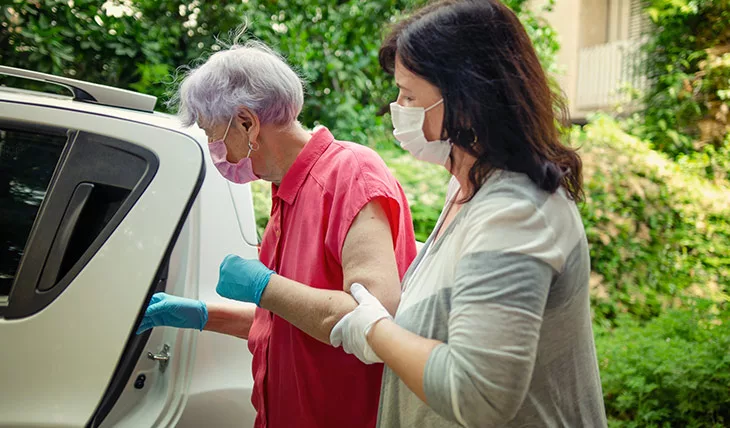For several years now, the health care industry has been promoting an emphasis on social determinants of health (SDOH) to improve health outcomes. These can include education, employment, nutrition, and transportation to name a few. The effort by Accountable Care and Managed Care Organizations (ACO/MCO) has been great to promote the effectiveness of adding these to a well-rounded preventative care model. But how does one determine what the needs are and, further, what resources are available?
In June 2021, The Centers for Medicare and Medicaid Services (CMS) published a guide promoting examples and sample use cases in the document “A Guide to Using the Accountable Health Communities Health-Related Social Needs (HRSN) Screening Tool: Promising Practices and Key Insights”. This document is interesting, as transportation professionals often look at the health care industry for guidance to improve services. Transportation can help meet many of the identified issues. The guide has 3 chapters and 4 appendices, providing a way to peruse the guide and access the most useful pieces of information for use.
Chapter 1 is an introduction to the screening tool along with a differentiation between SDOH and HRSNs. The guide describes HRSNs as being the effects of the negative SDOH circumstances providers need to identify and address. Looking at the identified list of HRSNs, one will see these are issues typically identified as inclusive in SDOH lists. These include (as viewed on page 5 of the guide):
- Housing instability
- Safety needs
- Food insecurity
- Lack of education
- Utility needs
- Lack of access to Medicaid transportation
- Financial strain
- Unemployment
- Lack of access to affordable health care or medicine
- Social isolation
- Stress
This chapter also recommends 3 main location types where screenings can occur: hospital settings, outpatient clinics, and other health care settings such as public health and pharmacies. Much emphasis is put on the importance of these as the shift in payment models from fee-for-service to value-based care has already arrived. Health outcomes cannot improve without addressing these critical areas.
Chapter 2 focuses on the use of the screening tool itself. The sections look at the various pieces of the tool and which of those can be revised to the specificity of the organization using the tool. The sections include:
-
Sample Introduction Text
This provides an example health and human service organizations (HHSOs) can use to help end-users know why they are being asked to use the tool and what the expected outcomes will be.
-
Domain Selection and Scoring Procedures
This describes how HHSOs can specify which of the core and supplemental domains they will include in the screening tool. In addition to topics, HHSOs can set up thresholds to indicate the level of assistance needed by the target audience. This way, resources can be spread out according to actual need.
-
Core Domains
The five core domains addressed here, and the recommendation is to include all five in the order they are currently assigned in the screening tool. These areas include:
- Living situation
- Food
- Transportation (this is exciting to see for those in the NEMT industry!)
- Utilities
- Safety
-
Supplemental Domains
These domains focus on the next level of needs to ensure a positive home, work, and social environment. The supplemental domains include:
- Financial strain
- Employment
- Family and community support
- Education
- Physical activity
- Substance abuse
- Mental health
- Disability
-
Screening Tool Administration
This section reviews the three versions of the screening tool as well as the three modes of administration. The three versions include standard, proxy, and multiuse. The three modes include self-administered, proxy-administered, and screener-administrated.
-
Administration Logistics
This section reviews the following three questions:
- How frequently screenings should occur
- Where screenings should occur
- When screenings should occur
The last area, Chapter 3, focuses on the promising practices that could result in universal HRSN screening. This section encourages HHSOs to focus on strategic planning on using the tool. Support is required organizational-wide when establishing any new procedure, so education and training is key in addition to ensuring a champion who can spearhead the process. Support from the highest levels of any organization is critical to the success of this tool for not just the professionals but for those who will be the beneficiaries of the results. This chapter also provides direct suggestions for training for various staff models and identifies not just the benefits but outlines potential challenges and considerations. Another significant enhancement is looking at population-based challenges with regards to individuals with behavioral health needs, older adults, those with low literacy ability, and those from various racial or ethnic groups, and sexual and gender minorities. Finally, a focus on managing safety, privacy, and ensuring a continuous quality improvement process for systematic improvements are addressed as well.
The last sections of this guide include the 5 appendices, providing the 3 versions of the screening tool, the background on how the model came to be, how the tool was developed, and finally suggestions of other HRSN screening tools available.
While transportation is identified as a core domain in this tool, most of the domains (whether core or supplemental) are near impossible to improve without some form of transportation. Available transportation can take the form of a personal vehicle (self, family, friend, neighbor), public transit, volunteers, and private-for-hire (taxi, accessible vehicles, Uber/Lyft) Identifying and providing referral to the resources is a great first step towards meeting these HRSNs. Without access, or transportation to and from, the resource continues to be beyond the reach of those who need them.
